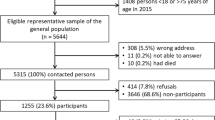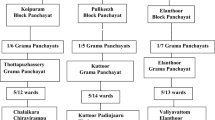Abstract
Background
The aim of the study was to obtain norms of the SF-36v2 health survey and the association of summary component scores with socio-demographic variables in healthy households of tuberculosis (TB) patients.
Design
All household members (18 years and above; healthy; literate) of registered tuberculosis patients who came for contact tracing during March 2010 to February 2011 at the respiratory clinic of Penang General Hospital were invited to complete the SF-36v2 health survey using the official translation of the questionnaire in Malay, Mandarin, Tamil and English. Scoring of the questionnaire was done using Quality Metric’s QM Certified Scoring Software version 4. Multivariate analysis was conducted to uncover the predictors of physical and mental health.
Results
A total of 649 eligible respondents were approached, while 525 agreed to participate in the study (response rate = 80.1 %). Out of consenting respondents, 46.5 % were male and only 5.3 % were over 75 years. Internal consistencies met the minimum criteria (α > 0.7). Reliability coefficients of the scales were always less than their own reliability coefficients. Mean physical component summary scale scores were equivalent to United States general population norms. However, there was a difference of more than three norm-based scoring points for mean mental component summary scores indicating poor mental health. A notable proportion of the respondents was at the risk of depression. Respondents aged 75 years and above (p = 0.001; OR 32.847), widow (p = 0.013; OR 2.599) and postgraduates (p < 0.001; OR 7.865) were predictors of poor physical health while unemployment (p = 0.033; OR 1.721) was the only predictor of poor mental health.
Conclusion
The SF-36v2 is a valid instrument to assess HRQoL among the households of TB patients. Study findings indicate the existence of poor mental health and risk of depression among family caregivers of TB patients. We therefore recommend that caregivers of TB patients to be offered intensive support and special attention to cope with these emotional problems.
Similar content being viewed by others
References
World Health Organization. (2009). Treatment of Tuberculosis; guidelines. http://whqlibdoc.who.int/publications/2010/9789241547833_eng.pdf. Accessed 30 May 2012.
Zarit, S. H., Reever, K. E., & Bach-Peterson, J. (1980). Relatives of the impaired elderly: Correlates of feelings of burden. The Gerontologist, 20(6), 649–655.
Stommel, M., Given, C. W., & Given, B. (1990). Depression as an overriding variable explaining caregiver burdens. Journal of Aging and Health, 2(1), 81–102.
Schulz, R., & Beach, S. R. (1999). Caregiving as a risk factor for mortality. JAMA: The Journal of the American Medical Association, 282(23), 2215–2219.
Glozman, J. M. (2004). Quality of life of caregivers. Neuropsychology Review, 14(4), 183–196.
Carter, J. H., Stewart, B. J., Archbold, P. G., Inoue, I., Jaglin, J., Lannon, M., et al. (1998). Living with a person who has Parkinson’s disease: The spouse’s perspective by stage of disease. Movement Disorders, 13(1), 20–28.
Macq, J., Solis, A., Martinez, G., Martiny, P., & Dujardin, B. (2005). An exploration of the social stigma of tuberculosis in five “municipios” of Nicaragua to reflect on local interventions. Health Policy, 74(2), 205–217.
Hansel, N. N., Wu, A. W., Chang, B., & Diette, G. B. (2004). Quality of life in tuberculosis: Patient and provider perspectives. Quality of Life Research, 13(3), 639–652.
Marra, C. A., Marra, F., Cox, V. C., Palepu, A., & Fitzgerald, J. M. (2004). Factors influencing quality of life in patients with active tuberculosis. Health and Quality of Life Outcomes, 2(1), 58.
Guo, N., Marra, F., & Marra, C. A. (2009). Measuring health-related quality of life in tuberculosis: A systematic. Health and Quality of Life Outcomes, 7, 14.
Rajeswari, R., Muniyandi, M., Balasubramanian, R., & Narayanan, P. (2005). Perceptions of tuberculosis patients about their physical, mental and social well-being: A field report from south India. Social Science and Medicine, 60(8), 1845–1853.
Martínez-Martín, P., Benito-Leon, J., Alonso, F., Catalan, M. J., Pondal, M., Zamarbide, I., et al. (2005). Quality of life of caregivers in Parkinson’s disease. Quality of Life Research, 14(2), 463–472.
Morimoto, T., Schreiner, A. S., & Asano, H. (2003). Caregiver burden and health-related quality of life among Japanese stroke caregivers. Age and Ageing, 32(2), 218–223.
Blanes, L., Carmagnani, M., & Ferreira, L. (2007). Health-related quality of life of primary caregivers of persons with paraplegia. Spinal Cord, 45(6), 399–403.
Grov, E., Dahl, A. A., Moum, T., & Fosså, S. D. (2005). Anxiety, depression, and quality of life in caregivers of patients with cancer in late palliative phase. Annals of Oncology, 16(7), 1185–1191.
Vellone, E., Piras, G., Talucci, C., & Cohen, M. Z. (2008). Quality of life for caregivers of people with Alzheimer’s disease. Journal of Advanced Nursing, 61(2), 222–231.
Dhuria, M., Sharma, N., & Ingle, G. (2008). Impact of tuberculosis on the quality of life. Indian Journal of Community Medicine: Official Publication of Indian Association of Preventive & Social Medicine, 33(1), 58–59.
Dhingra, V., & Rajpal, S. (2005). Health related quality of life (HRQL) scoring (DR-12 score) in tuberculosis—additional evaluative tool under DOTS. The Journal of Communicable Diseases, 37(4), 261–268.
Leplege, A., Ecosse, E., Verdier, A., & Perneger, T. V. (1998). The French SF-36 health survey: Translation, cultural adaptation and preliminary psychometric evaluation. Journal of Clinical Epidemiology, 51(11), 1013–1023.
Pappa, E., Kontodimopoulos, N., & Niakas, D. (2005). Validating and norming of the Greek SF-36 health survey. Quality of Life Research, 14(5), 1433–1438.
Demiral, Y., Ergor, G., Unal, B., Semin, S., Akvardar, Y., Kivicik, B., et al. (2006). Normative data and discriminative properties of short form 36 (SF-36) in Turkish urban population. BMC Public Health, 6(1), 247.
Fuh, J. L., Wang, S. J., Lu, S. R., Juang, K. D., & Lee, S. J. (2000). Psychometric evaluation of a Chinese (Taiwanese) version of the SF-36 health survey amongst middle-aged women from a rural community. Quality of Life Research, 9(6), 675–683.
Ware, J. E. Kosinski, M., Bjorner, J. B., Turner Bowker, D. M., & Maruish, M. E. (2007). User’s manual for the SF-36v2 health survey. Quality Metric Incorporated.
Riedijk, S., De Vugt, M., Duivenvoorden, H., Niermeijer, M., Van Swieten, J., Verhey, F., et al. (2006). Caregiver burden, health-related quality of life and coping in dementia caregivers: A comparison of frontotemporal dementia and Alzheimer’s disease. Dementia and Geriatric Cognitive Disorders, 22(5–6), 405–412.
Belasco, A. G., & Sesso, R. (2002). Burden and quality of life of caregivers for hemodialysis patients. American Journal of Kidney Diseases, 39(4), 805–812.
Nabuurs-Franssen, M., Huijberts, M. S. P., Nieuwenhuijzen Kruseman, A., Willems, J., & Schaper, N. (2005). Health-related quality of life of diabetic foot ulcer patients and their caregivers. Diabetologia, 48(9), 1906–1910.
Brazier, J. E., Harper, R., Jones, N. M., O’Cathain, A., Thomas, K. J., Usherwood, T., et al. (1992). Validating the SF-36 health survey questionnaire: New outcome measure for primary care. BMJ British Medical Journal, 305(6846), 160–164.
Hemingway, H., Nicholson, A., Stafford, M., Roberts, R., & Marmot, M. (1997). The impact of socioeconomic status on health functioning as assessed by the SF-36 questionnaire: The Whitehall II Study. American Journal of Public Health, 87(9), 1484–1490.
Gandek, B., Ware, J. E., Aaronson, N. K., Apolone, G., Bjorner, J. B., Brazier, J. E., et al. (1998). Cross-validation of item selection and scoring for the SF-12 health survey in nine countries: Results from the IQOLA project. Journal of Clinical Epidemiolog, 51(11), 1171–1178.
Loge, J. H., & Kaasa, S. (1998). Short form 36 (SF-36) health survey: Normative data from the general Norwegian population. Scandinavian Journal of Public Health, 26(4), 250–258.
Ware, J. E., Gandek, B., Kosinski, M., Aaronson, N. K., Apolone, G., & Brazier, J. (1998). The equivalence of SF-36 summary health scores estimated using standard and country-specific algorithms in 10 countries: Results from the IQOLA project. Journal of Clinical Epidemiology, 51(11), 1167–1170.
Lam, C. L. K., Tse, E. Y. Y., Gandek, B., & Fong, D. Y. T. (2005). The SF-36 summary scales were valid, reliable, and equivalent in a Chinese population. Journal of Clinical Epidemiology, 58(8), 815–822.
McHorney, C. A., Ware, J. E., & Raczek, A. E. (1993). The MOS 36-item short-form health survey (SF-36): II. Psychometric and clinical tests of validity in measuring physical and mental health constructs. Medical Care, 31(3), 247–263.
SF Health Surveys. http://www.qualitymetric.com/products/license/. Assessed 30 May 2012.
Montazeri, A., Goshtasebi, A., Vahdaninia, M., & Gandek, B. (2005). The short form health survey (SF-36): Translation and validation study of the Iranian version. Quality of Life Research, 14(3), 875–882.
Nunnally, J. C. (1967). Psychometric theory. Noida: Tata McGraw-Hill Education.
Palant, J. (2003). SPSS survival manual: A step by step guide to data analysis using SPSS. Philadelphia: Open University Press.
Thumboo, J., Fong, K. Y., Chan, S. P., Machin, D., Feng, P. H., & Thio, S. (2002). The equivalence of English and Chinese SF-36 versions in bilingual Singapore Chinese. Quality of Life Research, 11(5), 495–503.
Tseng, H. M., Jui-fen, R. L., & Gandek, B. (2003). Cultural issues in using the SF-36 health survey in Asia: Results from Taiwan. Health and Quality of Life Outcomes, 1(1), 72.
Lambert, M. L., Delgado, R., Michaux, G., Volz, A., Speybroeck, N., & Van Der Stuyft, P. (2005). Delays to treatment and out-of-pocket medical expenditure for tuberculosis patients, in an urban area of South America. Annals of Tropical Medicine and Parasitology, 99(8), 781–787.
Moore, K. (1998). Out-of-pocket expenditures of outpatients receiving chemotherapy. Onclolgy Nursing Forum, 25(9), 1615–1622.
Khan, A., Walley, J., Newell, J., & Imdad, N. (2000). Tuberculosis in Pakistan: Socio-cultural constraints and opportunities in treatment. Social Science and Medicine, 50(2), 247–254.
Baral, S. C., Karki, D. K., & Newell, J. N. (2007). Causes of stigma and discrimination associated with tuberculosis in Nepal: A qualitative study. BMC Public Health, 7(1), 211.
Medeiros, M. M. S., Ferraz, M. B., & Quaresma, M. R. (2000). The effect of rheumatoid arthritis on the quality of life of primary caregivers. The Journal of Rheumatology, 27(1), 76–83.
Knight, S. J., Latini, D. M., Hart, S. L., Sadetsky, N., Kane, C. J., DuChane, J., et al. (2007). Education predicts quality of life among men with prostate cancer cared for in the department of Veterans affairs. Cancer, 109(9), 1769–1776.
Jacobsen, B. K., & Thelle, D. S. (1988). Risk factors for coronary heart disease and level of education the tromsø heart study. American Journal of Epidemiology, 127(5), 923–932.
Ross, C. E., & Wu, C. (1995). The links between education and health. American Sociological Review, 60(5), 719–745.
Wee, H. L., Li, S. C., Cheung, Y. B., Fong, K. Y., & Thumboo, J. (2006). The influence of ethnicity on health-related quality of life in diabetes mellitus: A population-based, multiethnic study. Journal of Diabetes and Its Complications, 20(3), 170–178.
Azman, A. B., Sararaks, S., Rugayah, B., Low, L. L., Azian, A. A., & Geeta, S. (2003). Quality of life of the Malaysian general population: Results from a postal survey using the SF-36. Medical Journal of Malaysia, 58(5), 694–711.
Diener, E., Sandvik, E., Seidlitz, L., & Diener, M. (1993). The relationship between income and subjective well-being: Relative or absolute? Social Indicators Research, 28(3), 195–223.
Easterlin, R. A. (2001). Income and happiness: Towards a unified theory. The Economic Journal, 111(473), 465–484.
Acknowledgments
Authors would like to acknowledge Institute of Postgraduate Studies (IPS) at University Sains Malaysia for their support in carrying out this work through USM-RU-PRGS (1001/PFARMASI/844011).
Conflict of interest
None.
Author information
Authors and Affiliations
Corresponding author
Rights and permissions
About this article
Cite this article
Atif, M., Sulaiman, S.A.S., Shafie, A.A. et al. SF-36v2 norms and its’ discriminative properties among healthy households of tuberculosis patients in Malaysia. Qual Life Res 22, 1955–1964 (2013). https://doi.org/10.1007/s11136-012-0337-x
Accepted:
Published:
Issue Date:
DOI: https://doi.org/10.1007/s11136-012-0337-x




